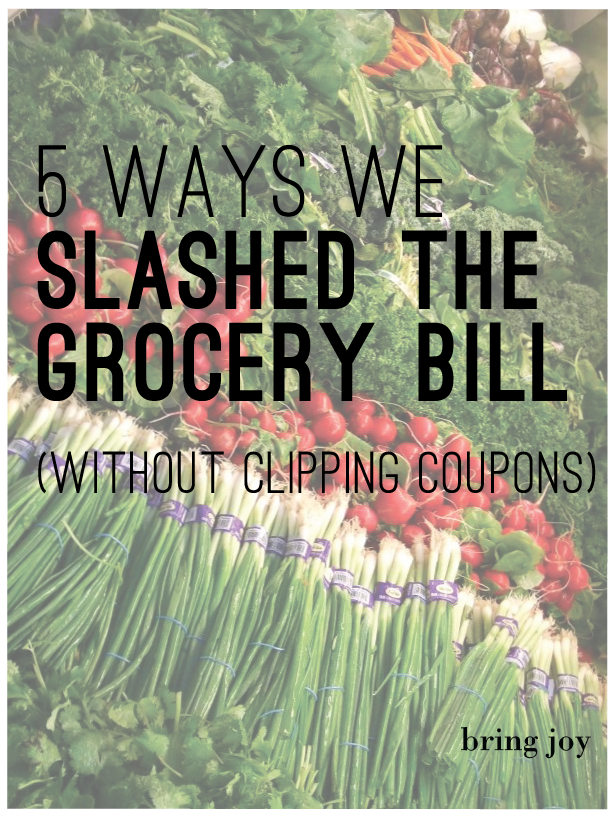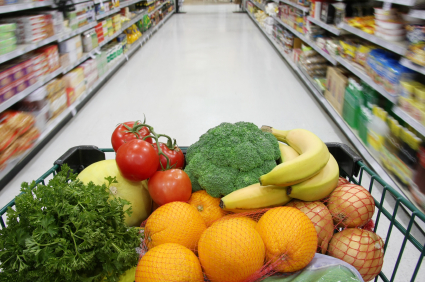 Original Image Source: Karen Daziel via flickr
Original Image Source: Karen Daziel via flickr
Last month, our family of 7, spent less than $500 a month on groceries.
Groceries have been my absolute last stand (next to our date money, which you know, I treat as holy sacred ground). I refuse to feed my family cheap, processed food. I also feel strongly about making sure they get a good dose of fresh fruits & veggies each day.
So, as each new month rolls around, I would tell myself, I need this (fair-trade organic chocolate), I need this (sparkling flavored water), I need this (PB2 powder–which I really do need, promise!), my kids need to choose from at least a dozen fruits to choose from each day. My peanut butter needs to be organic. I have to only use liquid gold pure maple syrup to sweeten our foods. You get the idea. Soon, our plant-based “frugal” diet is peppered with all sorts of products & non-essentials that really add to the bottom line.
According to the August 2014 USDA food plan, our family of 7 (2 adults, 5 children), should spend on the high end (liberal plan), $1939.10. Yes you read that correctly.
One thousand, nine hundred & thirty-nine freakin’ dollars. And ten cents.
On the low end, or the “thrifty” plan, we’re at $989.10. It’s the ball park range of what we’ve been spending the last year or so.
The past few months, however (since the beginning of the summer?), we’ve ratcheted our spending back even more, until in September, we spent less than $500. LESS THAN $500!
Here’s how we did it.
How you can save on your grocery budget
 Image Source: greggavedon.com via flickr
Image Source: greggavedon.com via flickr
Note: These numbers & figures are for informational purposes only. I’m not suggesting that you should or shouldn’t spend a certain amount, or buy or not buy certain foods, this is just what we did. I also realize a great deal of you place a high importance on eating unprocessed, sugar-free, unrefined, whole & organic foods. Me too!
But, at this point in my life, I’m trying to strike a careful balance of meeting my family’s nutritional needs while at the same time, saving as much as possible in order to pay off debt, live more frugally, & save for our future.
So some things have had to go, at least for the time being (100% pure maple syrup? check. agave? check. organic peanut butter? organic granola bars for the kids? check, check).
Please don’t judge me for the things we’ve cut or not cut. Like you, we’re learning as we go, trying to make the best, & most informed decisions we can by weighing opportunity costs & accessing the information on hand.
1. We have a menu plan. And stick to it.
I’m not a menu planner, in the most conservative sense.
But I do menu plan (sorta). In my 28 day meal plan, I explain exactly the format I use for meal planning. It works for us (we’ve been doing it for years), without being too restrictive.
My meal plan template gives us boundaries & guidance & also helps the kids by letting them know what they can look forward to. It also prevents unnecessary trips to the grocery store. It keeps us on track. When I stick with the plan, I save $$. It’s pretty much that simple.
This past month, in my menu planning, I focused on specific foods. Which brings me to point number two.
2. We stick to low-cost-per-calorie foods.
(Like rice, which you totally should eat more of).
I’m MMM‘s (Mr. Money Mustache) newest fan. I’ve spent a few hours of late, just perusing his site, laughing at his witty & wry (often profanity laced, FYI) humor. He *gets* frugality, but not in an obnoxious, tight-wad, penny pinching way.
In his post, Killing Your $1,000 Grocery Bill, he discusses the concept of keeping the average cost of a 667 calorie meal to under $1, & offers the following chart:
Cost per 667 calorie “Meal” of common foods:
Basmati Rice: 25 cents
Spaghetti noodles: 28 cents
Black beans (uncooked): 49 cents
Natural (peanuts only) Peanut Butter: 53.36 cents
California Raw Almonds: 80 cents
Bananas: 92 cents
Potatoes: 57 cents
Canola Oil: 14.38 cents
Organic Extra Virgin Olive Oil: 57 cents
Cheddar cheese: $1.09
Apples: $2.79
Organic cage-free eggs: $2.85
Organic boneless skinless chicken breast: $8.00
Note that rice, pasta, black beans, & peanut butter are among the lowest price per calorie foods. And these, along with wheat flour (to make homemade whole wheat bread, which I can do so at about $.75 per large loaf), corn tortillas, oatmeal, & a slew of other types of dried beans serve as our main calorie sources. Which, equals–cheap! Fruits & veggies, whatever happens to be on sale, or whatever is generally low-priced at Costco (like frozen strawberries, frozen green beans & broccoli) serve as our garnishes.
And think it’s no big deal to get that tiny, $8 jar of chocolate mint almond butter?
MMM has some words for you (& me!) from this post–Grocery Shopping With Your Middle Finger–which you should read in full (& please note, I have been known to be guilty of said “Sukka Consumer” behavior many a times):
Avoid Cutesy little Containers of things that cost $8.00.
Nowadays, organic and healthy food has caught on in a big way, especially among the affluent 20-to-40something crowd. When you combine a desire to do the right thing, with the typical free spending middle income earner, you get a highly profitable Sukka Consumer. And Whole Foods and Natural Grocers are right there to make the most of it, with tiny little jars of Mrs. McFancyPants’s Natural Ostrich Feather Butter for $18.99 and Jack McGillicuddy’s Organic Maple Elven Unicorn Syrup Crisp cereal for $77.59 for a 2-serving bag. When I visit the homes of middle-income people these days, I find the pantry absolutely loaded with these big-ticket small-quantity items, and then I understand why their grocery bills are $1000 per month.
All I have to say to that is–word.
I think the most eye-opening aspect of looking at your foods based on a per/calorie cost is realizing truly how pricey certain items are.
For example, as MMM points out in the above mentioned post, to eat 2,000 calories of organic blueberries (at $5.99 per 4 oz., which is at the high end), it would cost you $187(!), whereas, 2,000 calories of oatmeal costs roughly $.82.
As he so rightly declares,”Blueberries are about 229 times more expensive than rolled oats!!” That should get your attention.
I’m not saying don’t eat blueberries–I’m a blueberry lover myself. Just be smart about how much & what produce you’re buying, & if it is in fact, truly necessary to eat 4 cups of fresh blueberries each day.
Oatmeal, rice, pasta, beans, peanut butter. These are our some of our main staple foods & relying on them was what really enabled us to get our grocery bill so low last month.
{Note: I buy our oatmeal & dried refried beans in bulk from a LDS Home Food Storage center. You don’t have to be LDS to buy from the center. They offer some of the lowest prices on dried, pantry goods like oatmeal, pasta, & beans.}
3. We started using YNAB to budget.
YNAB is like no other budgeting system you’ve probably ever seen or used. It’s based on a philosophy that in order to “stick” with a budget, you’ve got to do four steps: give every dollar a job, save for a rainy day, roll with the punches, & live on last month’s income (still working on steps two & four).
The YNAB budgeting system is extremely present. It doesn’t care what you spent last month on groceries, or what you *think* you’ll spend next month on groceries.
→ Try a FREE 34-day full trial of YNAB (affiliate link)
& for bring joy readers–get 10% off your purchase if you decide to buy it!
It places priority on the money you have now, & the priorities (ie. bills & saving needs) you have now. Adjusting our spending & our budget based on this mindset (rather than, we will only spend X amount this month), encouraged me to think about using foods we already had before buying more, & think twice about shelling out a few extra bucks here & there for luxury items (like dark chocolate & organic nut butters).
If you have tried & failed, tried & failed to “stick” to a budget, I highly recommend giving YNAB a try (affiliate link)!
4. We stay the heck away from Whole Foods (& other such vendors).
I think I’ve spent less than a few hundred dollars at Whole Foods during my entire life. Don’t get me wrong. My big bleeding heart gets warm, warm fuzzies every time I walk through those doors to the magical land of organic, fair-trade, vegan, gluten-free, sugar-free fare. I fall into a trance, one in which I want to touch & smell & buy everything. Until. I look at the price. And then I want to laugh? cry? Or really, just get the blazes out of the store before my impulses get the better of me.
On our new reality (ie. ultra-frugality–because we’re going to get out of debt & then save a million dollars, reality) I aim to spend no more than $5 per each meal. When I was last at Whole Foods, I remember seeing a sign that actually made me laugh. It said–“Buy our store brand & make meals that cost less than $4 per serving!” I thought, sheesh for our family of 7, that’s only $28 per meal, $94 per day, $2,820 per month! Super deal.
Please don’t get me wrong.
I think Whole Foods is a great store. They treat their employees right. They offer a wide variety of healthy, nutritious foods & products that people want & can feel good about. But, if you’re like me, & don’t have money to burn, then I’d say Whole Foods is probably not the store to spend any amount of time in.
5. I make our own bread (& tortillas).
Since I’m the only gluten-free gal (thanks to a gluten intolerance, not Celiac’s) in the family, & don’t care too much about eating bread (I love, love homemade wheat bread, but not as crazy about gluten-free bread), I don’t buy or usually make bread for myself. But I do make my family plenty of whole wheat bread to nosh on.
Since I buy wheat berries in bulk (from the LDS Home Storage Center) at quite a good price ( & use my Blendtec to make my flour) I can make large loaves of wheat bread for less than $1 a loaf.
Joseph makes homemade flour tortillas, using mostly white flour (we buy in bulk from Costco), which cost just a cent or two per tortilla. There is huge savings for us, by making our own bread & tortillas (though we do buy our corn tortillas). And, fresh tortillas do make rice & bean eating a bit more enticing for the kids.
Final Thoughts
So, question is…is $500ish sustainable amount for our family? Or just a flash in the pan?
I’m not sure.
I hope we can keep it in the $450-$500 range, especially as we continue to make rice, beans, & oatmeal our staples.
(As a side note, the nice thing about doing YNAB is that there is a good amount of flexibility, while still staying “on-budget”.)
So far this month, we’re on track–I find that if I’m smart (& only get super on sale produce), I can get $40-$50 worth of produce each week, which seems to be enough. It’s not the variety that we’re used to, but I’m fine with eating lots of watermelon for a spell (during the summer), & lots of apples (now).
When it comes to spending & not spending, people get emotional.
As a person who values quality, good, & wholesome food (& realize that there is a strong link between what we eat & our health), I know how difficult it is to “give up” certain foods. The thing is, I’m learning, you can still eat quite well (especially in comparison to billions of other people in the world who don’t happen to live in a first world, RICH, country where food is, for the most part accessible & affordable).
My biggest piece of advice, based on our own personal experiences in the bring joy household?
Think outside the box.
Realize you’re not going to die from starvation or malnutrition if you scale back & focus on more frugal, wholesome low-price-per-calorie foods (I’m not talking ramen noodles or boxes of mac & cheese here).
With a little more effort, determination, & creativity, I know you can save a lot more on your grocery budget than you ever thought possible.
I know this, because I’ve done it myself.
Other bring joy posts you might want check out:



Comments